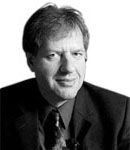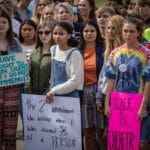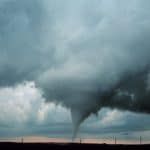The “public” discussion about the Energy Department’s Complex Transformation
By Hugh Gusterson | March 27, 2008
On Tuesday, the Energy Department held public hearings in Washington on its plans to “transform” the U.S. nuclear weapons complex. Last time I went to Energy headquarters I was turned away because I wasn’t a U.S. citizen. (See “Misadventures at the U.S. Energy Department.”) This time they let me in without inquiring about my citizenship; they even let me roam the halls unescorted to look for a bathroom. Go figure.
Mandated by the National Environmental Policy Act, the hearing was mainly attended by antinuclear activists waiting their turn at the microphone to condemn Energy’s draft environmental impact statement on the planned reconfiguration of the weapons complex. The Energy employee who showed me the way to the hearing room complained that most of the speakers would make big statements about the evils of nuclear weapons instead of speaking to the set of choices evaluated in Energy’s report. He was right. Out of the 27 speakers I heard, 23 used the opportunity to attack the fundamentals of U.S. nuclear weapons policy. Ted Wyka, the Energy official who presented the impact statement, sat there listening politely for two and a half hours. He looked the way I feel when getting a root canal.
I admired the activists’ tenacity. Although their views were clearly unwelcome, they came back to make their criticisms all over again.”
Energy is calling its plan to consolidate and rebuild the nuclear weapons complex “Complex Transformation.” The draft environmental impact statement evaluates four transformation options: a status quo option; the preferred option for consolidating functions and an alternative that would concentrate some functions still more; and a “capability-based” option that would assure a “capability to manufacture and assemble weapons at a nominal level,” which Energy defines as 50 nuclear weapons a year.
Energy’s “preferred” option would reduce square footage in the weapons complex by 9 million square feet and cut personnel by 20-30 percent. Like now, it would maintain eight facilities in seven states, but reconfigure some of their functions. For example, the Lawrence Livermore National Laboratory would lose its plutonium facility and hydrotesting capability, becoming more of a nuclear weapons research and development lab, while Los Alamos National Laboratory would enlarge its plutonium pit production rate by about eight times, but lose the work it does on high explosives and testing of warhead components in simulated environments. The preferred option is largely designed to consolidate highly enriched uranium, plutonium, and tritium (which are toxic and expensive to guard) in fewer places.
I admired the activists’ tenacity. Many complained that Energy had ignored their criticisms from an earlier hearing about how to shape the study now under discussion. Yet, although their views were clearly unwelcome, they came back to make their criticisms all over again. And, for three hours, they were in Energy’s inner sanctum, making stony Energy officials listen.
Many of the activists said the new complex would violate U.S. commitments to disarmament under Article VI of the Nuclear Non-Proliferation Treaty. The activists also, and this must be a first, kept invoking former Secretary of State Henry Kissinger with approval. (Kissinger recently signed on to two Wall Street Journal op-eds that called for the abolition of nuclear weapons; see “A World Free of Nuclear Weapons” and “Toward a Nuclear-Free World.”)
The critics were of three (not necessarily mutually exclusive) types: feminist, religious, and policy wonk. Ellen Barfield of the Women’s International League for Peace and Freedom summarized the feminist position succinctly: “We as women know the preciousness of every human life.” Timothy O’Connell of the Maryknoll Office for Global Concerns, one of many Christian speakers, said, “No nation should have the power to destroy God’s creation.” He added that real transformation came from the work his organization does with the poor. Sister Marie Lucy, a Franciscan nun, protested the use of the word “transformation,” a word connoting spiritual redemption in Christianity, to describe the perpetuation of nuclear weapons work.
The policy wonks engaged more directly with the environmental impact statement that occasioned the hearing. William Hartung of the New America Foundation dismissed Energy’s preferred option as “a bailout of the nuclear weapons industry,” and complained that Energy’s impact statement didn’t assess the risk that “Complex Transformation” would “provoke other countries to begin or accelerate efforts to seek their own nuclear arsenals.” Pointing out that many retired defense officials have now called for deep cuts in the nuclear stockpile, he excoriated the report for preempting the decisions of the next administration and omitting discussion of a logical and compelling fifth option–curatorship. “Weapons design, development, and experimentation would largely be eliminated under curatorship, while standby production capabilities would be maintained,” he said.
Chris Paine of the Natural Resources Defense Council pointed out that, in 1995, shortly after the Soviet Union collapsed, the U.S. nuclear weapons complex consisted of eight sites in seven states. By 2020, Energy’s preferred weapons complex “will still consist of the same eight sites in the same seven states, but this complex will be maintaining a stockpile that could well be one-tenth to one-twentieth the size.” (The eight sites are Livermore in California; Los Alamos and Sandia National Laboratories in New Mexico; the Nevada Test Site in Nevada; the Pantex Plant in Texas; the Kansas City Plant in Missouri; the Y-12 National Security Complex in Tennessee; and Savannah River Site in South Carolina.) Paine particularly criticized plans to maintain “two nuclear weapons design laboratories and an active test site almost 20 years after the end of the Cold War.” He advocated retrenching to a “Southwest Triangle” complex located around Amarillo, Albuquerque, Los Alamos, and the Nevada Test Site. This complex would have a small plutonium pit production capability.
Many years ago while writing a book about Livermore, Nuclear Rites: A Weapons Laboratory at the End of the Cold War, I discovered that the lab had written its final environmental impact statement for a new incinerator before holding public hearings and that the hearings were, unbeknownst to most participants, mere public theater. I wonder if the “Complex Transformation” hearings are also just theater. If so, they still serve a purpose, since they’re a rare venue today where fundamental questions are being asked about the U.S. nuclear arsenal.
The public hearings on Energy’s planned “Complex Transformation” have been confined to places that host nuclear weapons complex facilities. However, anyone can submit comments for the public record by e-mail at [email protected] or here. They can also send written comments to Ted Wyka at National Nuclear Security Administration, Office of Transformation NA-10.1, 1000 Independence Avenue, SW, Washington, D.C. 20585. All public comments must be received by April 10, 2008.
Together, we make the world safer.
The Bulletin elevates expert voices above the noise. But as an independent nonprofit organization, our operations depend on the support of readers like you. Help us continue to deliver quality journalism that holds leaders accountable. Your support of our work at any level is important. In return, we promise our coverage will be understandable, influential, vigilant, solution-oriented, and fair-minded. Together we can make a difference.
Topics: Columnists















